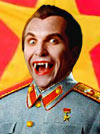|
Cinematic Hauntings Book review by Thomas M. Sipos |
|
MENU Books Horror Film Festivals and Awards
Pursuits
Blogs Horror Film Festivals and Awards
Other
|
Cinematic Hauntings, edited by Gary J. and Susan Svehla (Midnight Marquee Press; 320 pages; $20.00)
The editors claim "ghost films have been too often overlooked by film historians and critics." They intend to fill that gap in "the subtle side of horror" with this book. And it does, more so than not. Cinematic Hauntings contains 16 essays by different writers, each devoted to one of the following films: Blithe Spirit, Carnival of Souls, The Changeling, Curse of the Demon, The Haunting, High Plains Drifter, The Innocents, Lady in White, Legend of Hell House, Nomads, Outward Bound, Portrait of Jennie, Scrooge (the 1951 version, later retitled A Christmas Carol), The Shining, Supernatural, and The Uninvited. Because I accept the editors' premise -- the relative scarcity of text analyzing ghostly horror films -- I question some selections. If ghosts are spirits of deceased humans (or animals?) not all these films belong here. Some are a stretch. Is Carnival of Souls about a soul trapped between life and death, or a retelling of "An Occurrence At Owl Creek Bridge?" That can be good, demonstrating the resilient diversity of horror. But stretch a definition too far and the word loses meaning. Any way you slice it, Blithe Spirit is a comedy, and Curse of the Demon contains no ghosts. Randy Palmer, who wrote the essay on the latter, anticipates this objection, writing: "Initially it may not seem that Curse of the Demon has a place in a book devoted to a study of cinematic hauntings, but in fact the film journeys beyond the metaphysical borders separating the physical and spiritual worlds, and many of its elements fit neatly into the category." He characterizes the film's shape-shifting cat, orb of fire, and demon as "ghostly manifestations of evil." Well, no. These supernatural manifestations are not ghosts, even if they do look "ghostly." That said, Palmer's essay provides an excellent production history of both film and source material (Montague R. James's story, Casting the Runes), a detailed plot synopsis, and insightful commentary. This format is followed by the other essays -- production and distribution history, synopsis, commentary -- with varying degrees of emphasis. I'm glad The Changeling is represented. Although little known, after The Haunting it's arguably the most effectively atmospheric English-language ghost film ever made. But instead of the 1951 Scrooge, I wish Tom Johnson had covered the 1970 version (which he dismisses). In its original release, I recall Scrooge ending up (temporarily) in Hell. That scene was later dropped (perhaps because it wasn't in Dickens's version) but I'd like to have learned its history. Some entries need and deserve attention. Curse of the Demon deserves but does not need. I can understand not including Ghost (a romantic fantasy), but I wish Curse of the Demon and Blithe Spirit had been dropped in favor of Ghost Story and The Fog, both fitting candidates. Caveats aside, Cinematic Hauntings is an attractive and informative trade paperback, generously illustrated with 115 stills, posters, lobby cards, and backstage photos. All entries include crew and cast lists. Two include endnotes. If the subject matter interests you, you'll want this book. Review copyright by Thomas M. Sipos
|
"Communist Vampires" and "CommunistVampires.com" trademarks are currently unregistered, but pending registration upon need for protection against improper use. The idea of marketing these terms as a commodity is a protected idea under the Lanham Act. 15 U.S.C. s 1114(1) (1994) (defining a trademark infringement claim when the plaintiff has a registered mark); 15 U.S.C. s 1125(a) (1994) (defining an action for unfair competition in the context of trademark infringement when the plaintiff holds an unregistered mark).

